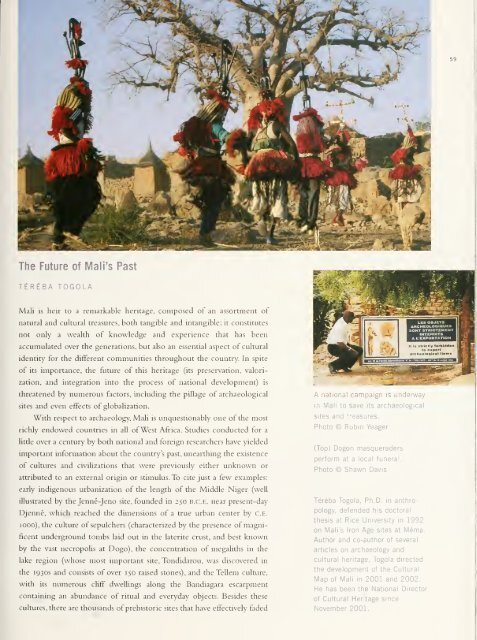SCOTLAND - Smithsonian Digital Repository - Smithsonian Institution
SCOTLAND - Smithsonian Digital Repository - Smithsonian Institution
SCOTLAND - Smithsonian Digital Repository - Smithsonian Institution
Create successful ePaper yourself
Turn your PDF publications into a flip-book with our unique Google optimized e-Paper software.
The Future of Mali's Past<br />
t£reba togola<br />
Mali is heir to a remarkable heritage, composed of an assortment of<br />
natural and cultural treasures, both tangible and intangible; it constitutes<br />
not only a wealth of knowledge and experience that has been<br />
accumulated over the generations, but also an essential aspect of cultural<br />
identity for the different communities throughout the country. In spite<br />
of its importance, the future of this heritage (its preservation, valorization,<br />
and integration into the process of national development) is<br />
threatened by numerous factors, including the pillage of archaeological<br />
sites and even effects of globalization.<br />
With respect to archaeology, Mali is unquestionably one of the most<br />
richly endowed countries in all of West Africa. Studies conducted for a<br />
httle over a century by both national and foreign researchers have yielded<br />
important information about the country's past, unearthing the existence<br />
of cultures and civilizations that were previously either unknown or<br />
attributed to an external origin or stimulus. To cite just a few examples:<br />
A nati gn is underway<br />
in Mali to save its archaeological<br />
sites and treasures.<br />
Photo © Robin Yeager<br />
(Top) Dogon masqueraders<br />
perform at a local funeral.<br />
Photo © Shawn Davis<br />
early indigenous urbanization of the length of the Middle Niger (well<br />
Ulustrated by the Jenne-Jeno site, founded in 250 B.C.E. near present-day<br />
Djenne, which reached the dimensions of a true urban center by C.E.<br />
1000), the culture of sepulchers (characterized by the presence of magnificent<br />
underground tombs laid out in the laterite crust, and best known<br />
by the vast necropoUs at Dogo), the concentration of megaliths in the<br />
Tereba Togola, Ph.D. in anthropology,<br />
defended his doctoral<br />
thesis at Rice University in 1992<br />
on Mali's Iron Age sites at Mema.<br />
Author and co-author of several<br />
articles on archaeology and<br />
lake region (whose most important site, Tondidarou, was discovered in<br />
cultural<br />
heritage, Togola directed<br />
the 1930s and consists of over 150 raised stones), and the Tellem culture,<br />
with its numerous cUff dweUings along the Bandiagara escarpment<br />
containing an abundance of ritual and everyday objects. Besides these<br />
cultures, there are thousands of prehistoric sites that have effectively faded<br />
the development of the Cultural<br />
Map of Mali in 2001 and 2002.<br />
He has been the National Director<br />
of Cultural<br />
November 2001.<br />
Heritage since
















